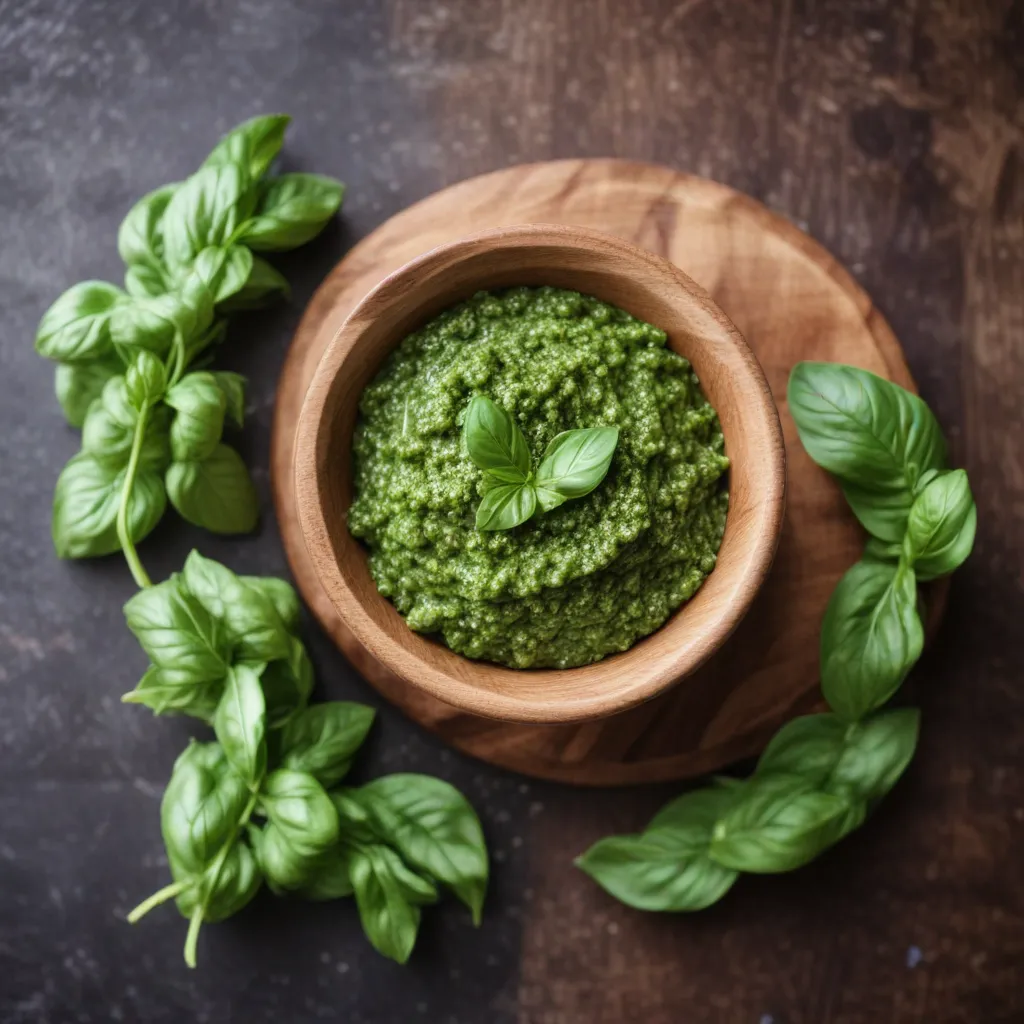
Vibrant, flavorful pesto is a culinary delight that can elevate a wide range of dishes, from pasta and pizza to soups and sandwiches. At the Wine Garden Inn, we take pride in showcasing the bounty of our estate-grown produce, and one of our favorite ways to do so is through the creation of a stunning, emerald-hued pesto.
Pesto Preparation
The key to making a bright green pesto lies in the careful selection and handling of the ingredients. Start with a generous bunch of fresh basil leaves, which provide the foundation for the pesto’s flavor profile. For an added boost of color and nutrition, you can also incorporate a handful of baby spinach leaves. The spinach not only amplifies the verdant hue, but also contributes a subtle sweetness that complements the basil.
Ingredients
To make a vibrant pesto, you’ll need:
* 6 cups (slightly compressed but not packed) fresh basil leaves
* Up to 1 cup baby spinach leaves
* 3/4 cup toasted pine nuts
* 6 large garlic cloves
* 1/2 teaspoon salt
* 1 cup extra-virgin olive oil
* 1.5 cups freshly grated Pecorino Romano or Parmesan cheese
* Lemon juice, to taste
Blending Techniques
The key to preserving the pesto’s bright green color is to minimize oxidation. Start by blanching the basil and garlic in boiling water for less than a minute, just until they turn bright green. This helps to lock in the chlorophyll, the pigment responsible for the vivid hue. Immediately transfer the blanched leaves and garlic to an ice bath to stop the cooking process.
Once drained and dried, add the basil, garlic, pine nuts, and salt to a food processor. Pulse the mixture until it’s finely chopped and starting to come together. With the processor running, slowly drizzle in the olive oil until the pesto reaches a smooth, creamy consistency.
Flavor Profiles
The addition of a few drops of fresh lemon juice can provide a subtle brightness that accentuates the pesto’s verdant flavor. Alternatively, you can experiment with other herbs, such as parsley or arugula, to create unique flavor profiles. The Pecorino Romano or Parmesan cheese adds a savory, umami note that balances the sweetness of the basil and the richness of the olive oil.
Vibrant Green Color
One of the most striking features of a well-made pesto is its vibrant green hue. This color is a direct reflection of the pesto’s chlorophyll content, which is preserved through the careful handling of the ingredients.
Chlorophyll Content
Chlorophyll is the pigment responsible for the green color in plants, and it’s found in abundance in leafy greens like basil and spinach. By blanching the leaves briefly in boiling water, you’re able to lock in the chlorophyll and prevent it from breaking down, resulting in a pesto that retains its vivid green color.
Ingredient Selection
In addition to the blanching technique, the choice of ingredients can also impact the pesto’s color. Selecting the freshest, highest-quality basil and spinach, and avoiding any leaves with blemishes or discoloration, will ensure a consistently bright green pesto. The use of extra-virgin olive oil also helps to maintain the pesto’s vibrant appearance.
Presentation Considerations
When it comes to serving the pesto, the color is an important factor to consider. The bright green hue makes for a visually stunning presentation, especially when paired with light-colored pasta, drizzled over roasted vegetables, or used as a spread on crostini. The contrast of the emerald-green pesto against a neutral backdrop can be truly captivating.
Culinary Applications
Pesto’s versatility makes it a staple in many kitchens, as it can be utilized in a variety of dishes to add a burst of flavor and visual appeal.
Pasta Dishes
One of the classic ways to enjoy pesto is tossed with pasta. The pesto’s creamy texture coats the noodles, while the bold flavors of the basil, garlic, and cheese complement the starch. For a delightful spin, try incorporating the pesto into a baked pasta dish or using it as a sauce for homemade ravioli.
Spreads and Dips
Pesto also shines as a spread or dip, whether it’s served with crusty bread, crostini, or as an accompaniment to crackers and vegetables. The vibrant color and flavor can elevate a simple appetizer or snack into something truly special.
Vegetable Accompaniments
The pesto’s herbaceous notes make it an excellent pairing for a variety of roasted, grilled, or sautéed vegetables. Try drizzling the pesto over asparagus, zucchini, or tomatoes to add a burst of flavor and visual interest to your plate.
Nutritional Benefits
Pesto not only delights the senses with its vibrant color and robust flavor, but it also offers a range of nutritional benefits.
Antioxidant Properties
The chlorophyll in the basil and spinach used in the pesto is a powerful antioxidant, helping to neutralize free radicals and support overall health. Additionally, the pine nuts and olive oil are rich in beneficial fats and vitamins that can contribute to a balanced diet.
Vitamin and Mineral Content
Basil is an excellent source of vitamin K, vitamin A, and manganese, while spinach provides vitamins A, C, and K, as well as iron and magnesium. These essential nutrients can help support bone health, immune function, and overall well-being.
Dietary Considerations
For those following a plant-based or vegan diet, pesto can be a delicious and nutritious option by omitting the Pecorino Romano or Parmesan cheese and opting for a dairy-free alternative, such as nutritional yeast or cashew cream.
Whether you’re enjoying it as a pasta sauce, a spread, or a vegetable accompaniment, this vibrant, flavorful pesto is sure to delight the senses and nourish the body. Discover the joy of Estate-Grown Pesto at the Wine Garden Inn!
